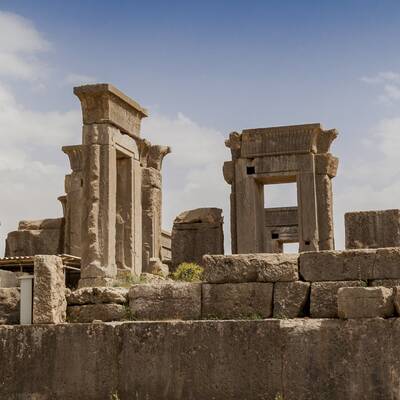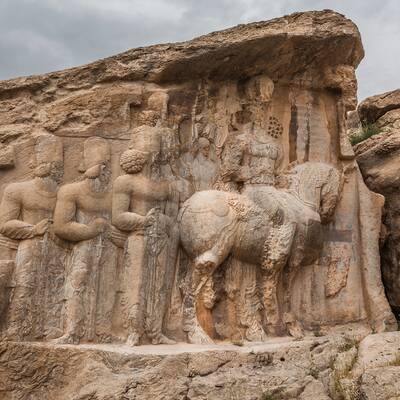
Naqsh-e Rostam
Naqsh-e Rostam is a set of ancient monuments which is placed in Zangi Abad village, one of the environs of Marvdasht city, in Fars Province. This ancient and old heritage is close to Persepolis, including some memorials of different Elam kingships like the relief of the king and queen and also several reliefs related to Achaemenid and Sassanid kings.
The other name of this region is Se Gonbadan (which means three domes) which is the name of a nearby mountain. Among other attractions of this area, we can mention to Hajiabad Mountain, Estakhr Mountain, Nefesht or Do Gonbadan (two Domes) to which the historic sources mentioned. This historic site was excavated by some archaeologists like Ernst Herzfeld and Erich Friedrich Schmidt.
the Ka'ba-ye Zartosht, or the Cube of Zoroaster, which is also called Bon Khanak is a stone cube; it is five meters long, five meters wide and twelve meters high, which have been built along with a staircase of 30 stairs. The history of Bon Khanak backs to the Achaemenid era and there are various assumptions about its functions. It has a wall inscription in three scripts of Parthian and Sassanid Pahlavi and the Greek script, from Shapur I and Kartir, the greatest priest of the time.
The tomb of Darius the great is a dug-out hole in the mountain stone with a cross façade decorated by four columns with cow capitals. The entrance leads to a hall with three rooms, each with one grave. The figure of Darius with an archery in his hand has been depicted on top of the entrance; he is standing on the royal thron surrounded by his companions. Twenty-eight people are carrying the thrown of Darius as the symbol of twenty-eight Satrapi in the empire.
There is a fireplace in front of the great king above of which the symbol of Faravahar has been depicted. The sun is rising right in front of the king. There are two inscriptions in ancient Persian, Elamite and Akkadian, which read: “A great god is Ahura Mazda, who created the happiness for man; By the favor of Ahura Mazda, my desire is the right path,” “I am Darius the great king, king of kings, king of countries containing all kinds of men, king in this great earth far and wide.”
The tombs of three other kings of the Achaemenid empire are also here is Naqsh-e Rostam; those of Xerxes I, Artaxerxes I and Darius II. All tombs are similar standing next to the tomb of Darius the great.
There are also seven reliefs which are the memorial of Sassanid kings on the hillside of the mountain carved on the stone. The first one belongs to Artaxerxes I, 50 meters side, four meters high and 15 centimeters thick. The founder king of Sassanid empire is sitting on the back of a hours receiving the royal crown from the highest priest. His left hand is up as showing some respect to Ahura Mazda and the royal crown includes a long ribbon. There is an inscription in this relief placed right on the horse’s breast, which reads: “the horseman of the deities is the great king of Iran, Babak’s son, …”.
On the right side of the relief of Artaxerxes coronation, you can see the relief of Bahram II along with eight of his companions. The king’s hands are placed on the sword’s hilt and the crown has two wings on two sides.
The third relief is visible below the monument of the Darius II of Achaemenid and it is approximately nine meters wide. In this depiction, you can see the Sassanid Bahram II’s triumph over one of his enemies. The enemy has been tumbled, his spear is broken and one of his fellows is attacking behind the back of the king.
The relief of Hormoz II fight, the Sassanid king, is visible below the tomb of Artaxerxes I of Achaemenid.
The fifth depiction is a special relief on the triumph of Shapur I over the Valerian, the Roman emperor. King is here is sitting on the back of a hours, forgiving the Valerian who is bending his knee. The king has a jagged crown and he is wearing earrings, pants and the coat.
In the sixth relief, below the tomb of Darius the great, you can see the Bahram IV, who is also called Bahram Gur. He is in the battle and has a spear in his hand.
The seventh relief is depicting the coronation ceremony of Narseh who is receiving the crown or ring from Anahita, the divinity of the waters. The Sassanid king has been worn a tight coat, a pear necklace and his hair is tousled.



